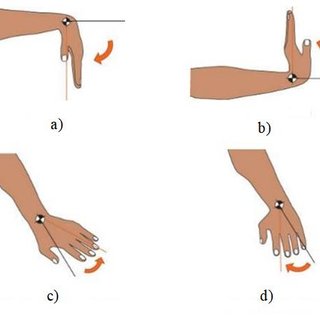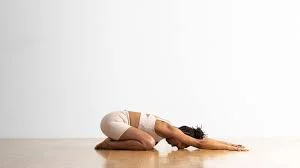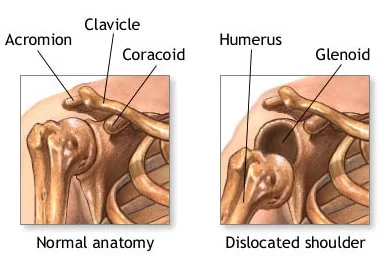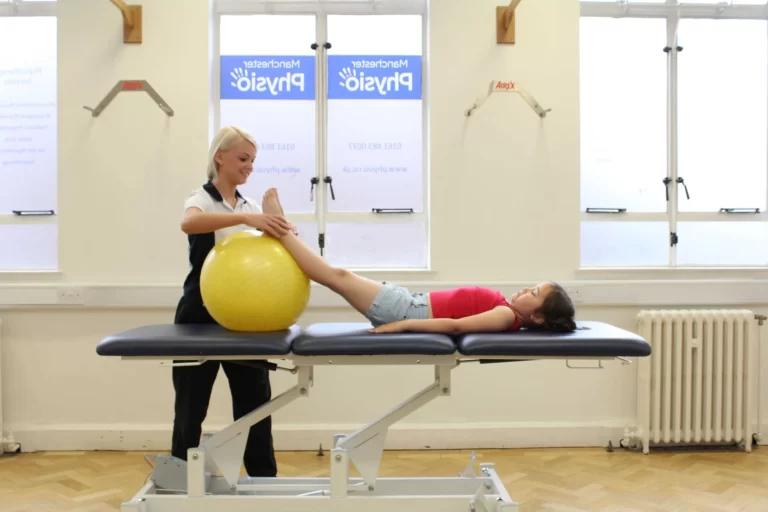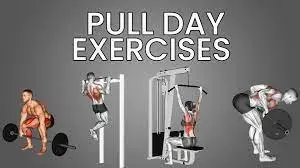Wrist Exercises: Health Benefits, How to do ?-Variation
What is Wrist Exercise?
After any problem in the wrists, hands, or fingers, it’s essential to get movement and strength back. This supports tissue healing and will aid you get moving again. You may not be able to return to your usual exercise levels urgently and improvements may be slow to begin with. However, a gradual return to normal activities is the great way to get good short and long-term results after a wrist, hand, or finger issue.
When performing the exercise you should listen to your pain levels, especially in the early stages. You may find that these exercises increase your symptoms slightly in the starting. However, they should get easier over time and, with daily practice, can help to improve motion in the wrists, hands, or fingers.
Wrist exercises aid to build strength in the muscles surrounding your wrists to support a full range of motion. Strong wrists are important for avoiding repetitive motion injuries such as carpal tunnel syndrome. Physical therapists will often prescribe a wrist exercises to assist patients to recover from injury or regain mobility after surgery.
Anatomy of Wrist joint
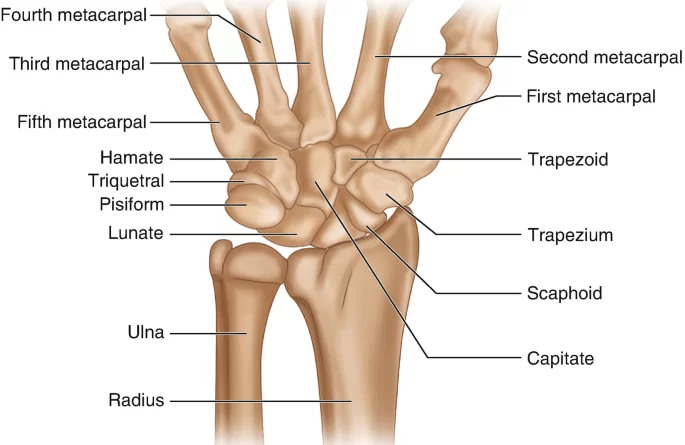
The radiocarpal joint is a synovial joint created between the radius, its articular disc, and three proximal carpal bones; the scaphoid, lunate and triquetral bones. Technically, the radiocarpal joint is observed to be the only articular component of the wrist joint. The primary motions of the radiocarpal joint are flexion, extension, abduction, and adduction.
Carpal bones in the wrist:
Your wrist is made up of eight small bones known as the carpal bones, or the carpus. These irregularly shaped bones connect your hand to the two long forearm bones: the radius and ulna. The cluster of carpal bones in the wrist makes it both flexible and strong. Your wrist and hand wouldn’t function the same if your wrist joint were only made up of one or two larger bones.
The eight carpal bones are:
- A scaphoid is a long boat-shaped bone below your thumb
- Lunate, a crescent-shaped bone beside the scaphoid
- Trapezium, a rounded-square shaped bone above the scaphoid and under the thumb
- Trapezoid, a wedge-shaped bone beside the trapezium
- the capitate is an oval or head-shaped bone in the middle of the wrist
- Hamate, a wedge-shaped bone below the pinky finger side of the hand
- Triquetrum, a pyramid-shaped bone under the hamate
- Pisiform, a small, pea-shaped sesamoid bone that sits on top of the triquetrum
The wrist has three main joints. This makes the wrist extra stable than if it had only one joint. It also promotes your wrist and hand a wide range of movement, allowing for many different movements and positions. The wrist joints allow your wrist to move your hand up and down, like when you raise your hand to wave. These joints allow you to rotate your hand and flex your wrist backward and forward as well as side to side.
Radio carpal joint: The radio carpal joint is where the radius and the thicker forearm bone join with the bottom row of the wrist bones- the scaphoid, lunate, and triquetrum bones. This joint is mostly on the thumb side of your wrist.
Ulnocarpal joint: This is the joint between the ulna and the thinner forearm bone and the lunate and triquetrum wrist bones. This is the pinky finger side of the wrist.
Distal radio ulnar joint: This joint is in the wrist but doesn’t involve the wrist bones. It joins the bottom ends of the radius and ulna.
What are the Health Benefits of Wrist Exercises?
There are some Health Benefits of doing Wrist Exercises:
- Activating muscles and blood flow: Stretching your wrists can activate your forearm and hand muscles and increase blood flow to the area. Stretching makes it easier to use the forearm muscles when performing a strenuous exercise program like yoga, strength training, or lifting weights.
- Increasing your short-term range of motion: Wrist stretches improve the range of motion of your wrist, fingers, and forearms, allowing you to do deeper stretches or fully activate a particular muscle. If you feel a lot of stiffness or tightness in your wrists or are about to perform an arm workout and want to do as much of each motion as possible, wrist stretches can be a great option.
- Increase long-term flexibility: Over time, consistent, safe wrist stretches can improve the long-term flexibility of your wrists, fingers, and forearms, allowing you to do deeper stretches and hold them longer. Better long-term wrist mobility can also aid mitigate wrist pain from sprains, carpal tunnel syndrome (pinching of the median nerve caused by repetitive motions), or tendonitis (inflammation of tendons).
- Relieve muscle soreness: Athletes commonly stretch before or after a workout to reduce muscle soreness. Stretching your wrists may offer relief in the form of a placebo effect since it activates your muscles and can aid you in believing that your soreness will subside.
- Wrist exercises increase flexibility: The wrist is capable of a wide range of motions, including pronation, supination, and radial/ulnar deviation. Wrist exercises aid stretch the ligaments in the wrist to promote wrist mobility and increase flexibility.
- Wrist exercises help prevent wrist pain and injury: Weak wrists are more prone to fractures and sprains. Repetitive motions can cause wrist pain by placing undue stress on the median nerve (the nerve extending from your hand to your upper arm), which can lead to carpal tunnel syndrome. Building strength in your wrist muscles aids alleviate stress on the median nerve and gives strength to protect the wrists from injury.
- Wrist exercises help build grip strength: The range of motion used to perform wrist exercises engage the forearm muscles to help build grip strength. A strong grip is important for many upper-body exercises, such as pull-ups and barbell bench presses.
Some Wrist Exercises related to specific conditions
This exercise includes:
- Wrist Exercises for Tendonitis
- Wrist Exercise after Fracture
- Wrist Drop Exercises
- Wrist Exercise after Surgery
- Wrist Exercises for Strength
- Sprained Wrist Exercise
- Wrist Exercise for Arthritis
Wrist Exercises for Tendonitis
Here is some exercise for tendonitis:
- Wrist flexion
- Wrist extension
- Radial and Ulnar Deviation
- Forearm Pronation and Supination
- Grip Strengthening
- Wrist Stretches
- Thumb Stretch
- Wrist Warm-Up
Wrist flexion
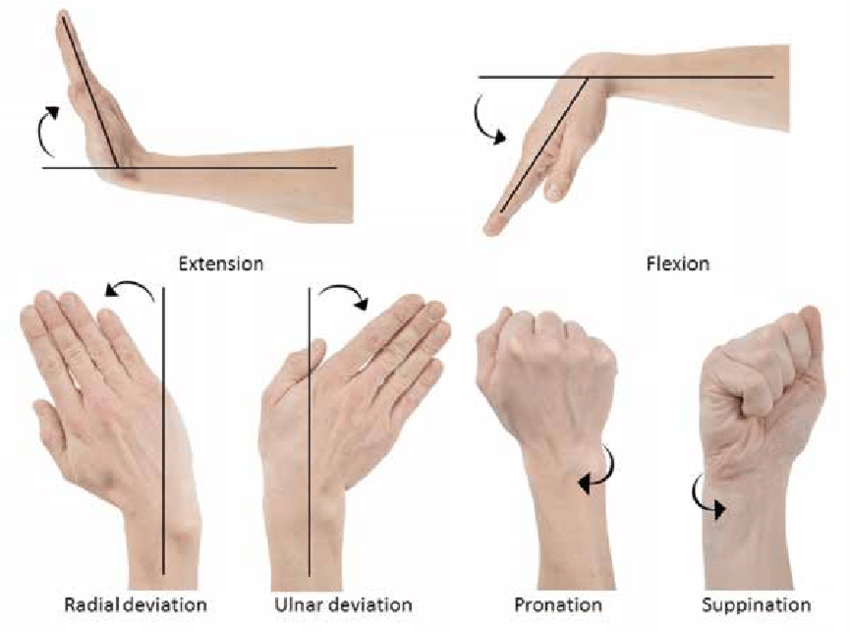
Grab a can or hammer handle in your hand with your palm facing up. Flex your wrist upward. Slowly lower the weight and return to the beginning position. Perform 3 sets of 10. Gradually raise the weight of the can or weight you are holding.
Wrist extension
Grab a soup can or hammer handle in your hand with your palm facing down. Slowly flex your wrist upward. Slowly lower the weight down into the beginning position. Perform 3 sets of 10. Gradually add the weight of the object you are holding.
Radial and Ulnar Deviation
Begin with the thumb facing up toward the ceiling. Alternate between bringing the thumb side up toward the roof and then dropping the pinkie side down toward the floor. Hold for 3-5 seconds with each motion, alternate back and for up to 20 times as needed. Or put your hand flat on a table and do side to side motion.
Forearm Pronation and Supination
With your elbow flexed 90°, turn your palm upward and pause for 5 seconds. Slowly turn your palm downward and pause for 5 seconds. Make sure you keep your elbow at your side and flex 90° throughout this exercise. Perform 3 sets of 10. When this exercise becomes pain-free, perform it with some weight in your hands such as a soup can or hammer handle.
Grip Strengthening
Compress a rubber ball and hold for 5 seconds. Perform 3 sets of 10.
Wrist Stretches
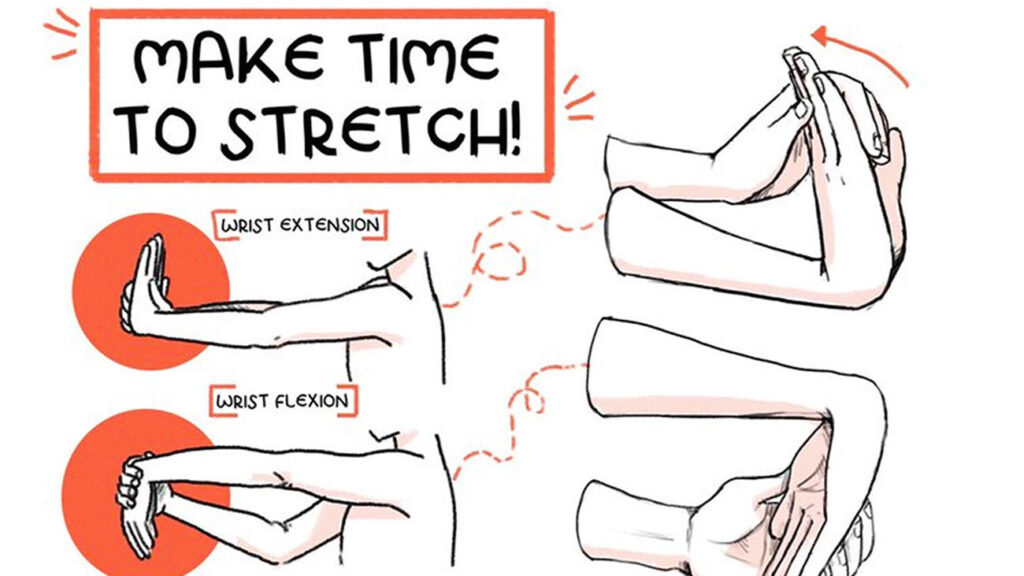
To increase flexibility and find relief from pain, try some simple stretches of the affected wrist tendons. This is especially essential if you are feeling stiffness from wearing a wrist splint. Concentrate on sitting or standing in a relaxed position with good posture to optimize each stretch.
Wrist Extension Stretch
To stretch the wrist flexor muscles, begin by holding the wrist in extension. To perform so, stretch your arm out in front of you with the elbow straight and palm facing down. Then, utilize the opposite hand to gently push the palm and wrist up into extension. Hold for 15-30 seconds for up to 3 sets. Do not force the stretch and modify if you feel pain or nerve symptoms. To progress, you can put your hands in a “prayer” pose in front of your chest to stretch both hands at once.
Wrist Flexion Stretch
This time, you will stretch the wrist extensors by bending the wrist. Once again, your arm will be out in front of you with the elbow extended and palm facing down. This time, utilize the opposite hand to push the back of your hand down toward the ground into a bent wrist position. Hold 15-30 seconds for 2-3 sets.
Thumb Stretch
Begin by bringing your thumb across your palm toward the base of your pinkie finger. Then, wrap your fingers around the whole thumb. With your arm out straight and pinkie down toward the ground, let the wrist gently flex sideways as you bring your pinkie closer to the floor. Hold 15-30 seconds for 2-3 sets. You should experience this stretch at the base of the thumb and side of your wrist.
Wrist Warm-Up
Sit in a cozy chair with the forearm supported on an armrest, or your thigh if necessary, with free space for the hand to move. Simply warm up the wrist and hand by moving them around in circular movements. You can perform finger flexion and extension to the move as your wrist loosens up. Complete 12-15 circles in each direction as needed.
Wrist Exercise after Fracture
Below are some exercises after a fracture that improve your wrist joint range of motion and routine activities:
- Tendon glides
- Thumb Opposition
- Hand pumps
- Wrist flexion
- Wrist extension
- Radial and Ulnar Deviation
- Wrist supination stretch
- Forearm pronation and supination
- Wrist extension / weight-bearing
- Hand grip Exercises
- Putty Exercises for Thumb and Fingers
- Wrist and Forearm Strengthening
Tendon glides
Begin with an open palm and then flex your fingers to a claw hand. Back to an open palm and then to an “L hand”. Back to an open your palm and then make a flat fist. Back to an open palm and then make a full fist with finger pads in your palm.
Finally, return to an open palm and then repeat (same order).
Thumb Opposition
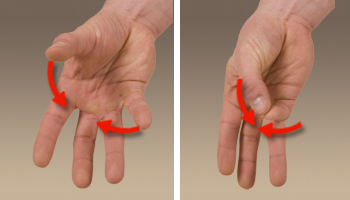
Start with an open palm and fingers extended. Then, touch the tips of the first and second fingers. Then back to open palm. Next, touch the tips of the first and third fingers, etc until all fingers have been done.
Hand pumps
Hold your hand upward. Open and close the hand into a fist and repeat. If you cannot make a full fist, then make a half fist. This can aid in reducing swelling and stiffness.
Wrist flexion
Grab a can or hammer handle in your hand with your palm facing up. Flex your wrist upward. Slowly lower the weight and return to the beginning position. Perform 3 sets of 10. Gradually improve the weight of the can or weight you are holding.
Wrist extension
Grab a soup can or hammer handle in your hand with your palm facing down. Slowly flex your wrist upward. Slowly lower the weight down into the beginning position. Perform 3 sets of 10. Gradually improve the weight of the object you are holding.
Radial and Ulnar Deviation
This move is similar to the motion above, except this time the wrist motion is side to side. Begin with the thumb facing up toward the ceiling. Alternate between bringing the thumb side up toward the roof and then dropping the pinkie side down toward the ground. Hold for 3-5 seconds with each motion, alternate back and for up to 20 times as needed.
Wrist supination stretch
Elbow bent 90 & held at your side, turn your wrist palm up. Using your other hand grab your wrist (from underneath) at the
bottom of the forearm & assist the movement.
Forearm pronation and supination
With your elbow flexed 90°, turn your palm upward and pause for 5 seconds. Slowly turn your palm downward and pause for 5 seconds. Make sure you keep your elbow at your side and flex 90° throughout this exercise. Perform 3 sets of 10. When this exercise becomes pain-free, perform it with some weight in your hands such as a soup can or hammer handle.
Wrist extension / weight-bearing

Put both hands on a table and gently lean forward until a stretch is felt. Weight bear as able through the wrist. Be aware this it may take a couple of weeks before you can tolerate weight through the wrist.
Hand grip Exercises
Your PT may prescribe specific exercises to aid improve your handgrip strength.
Exercises to increase hand grip may include:
Towel gripping (squeezing and holding a rolled towel)
Hand grip exercises with a Digi-Flex device (a hand-therapy tool)
When doing gripping exercises, be sure to hold each repetition for a few seconds, and grip with slow, deliberate movements. Do each exercise for 10 to 15 repetitions.
Putty Exercises for Thumb and Fingers
To aid improve the strength of your fingers after a Colles’ fracture, your physical therapist may prescribe putty exercises to do.
Compress the putty between your thumb and fingers, and then squeeze it between two individual fingers. You can also roll the putty into a long tube and make it into a ring. Put the ring around your fingers to work on extending your fingers against resistance.
Wrist and Forearm Strengthening
A small weight can be used to increase wrist strength.
The muscles around your forearm and wrist may be weak from the injury and your wrist being immobilized. Your physical the therapist may prescribe wrist strengthening exercises with a dumbbell to help increase your strength.
Remember to begin slowly with a lightweight. Once your wrist strengthens, you can jump to a heavier weight.
Do wrist flexion and extension with dumbbells.
You can use thera belt also.
Wrist Drop Exercises
Some exercises can aid reverse the nerve compression and relieve the pain and tenderness in your wrist. It is suggested that you do them for at least six to 12 weeks, unless your doctor tells you otherwise.
Here are some exercises for wrist drops:
- Wrist Extension Stretch
- Wrist Flexion Stretch
- Wrist Supination
- Radial Nerve Glide
- Ball Squeeze
- Rubber Band Stretch
- Hammer Rotation
Wrist Extension Stretch

Hold your injured arm extended in front of you, but prevent locking your elbow.
Flex your wrist backward so that your fingers point toward the roof, as though you’re signaling someone to “stop.”
Utilize your other hand to pull the fingers of your injured hand back toward you, until you feel the stretch on the inside of your forearm.
Hold here for 10-15 seconds.
Repeat five times.
Perform this exercise four times a day.
Wrist Flexion Stretch
Hold your injured arm extended in front of you, but prevent locking your elbow.
Flex your wrist forward so that your fingers point toward the ground.
Utilize your other hand to pull the fingers of your injured hand back toward you, until you feel the stretch on the outside of your forearm.
Hold here for 10-15 seconds.
Repeat five times.
Perform this exercise four times a day.
Wrist Supination
Flex the elbow of your injured hand and keep it close to your body, near your ribs.
Turn your palm upward so that it faces the roof.
Utilize your other hand to turn your forearm further into the palm-up position until you feel the stretch.
Hold here for 15 seconds.
Repeat five times.
Perform this exercise four times a day.
Radial Nerve Glide

Stand in a comfortable pose with your arms by your sides.
Let go of the shoulder of your injured arm and stretch your fingers downward.
Roll your arm inward (your thumb should point toward the body).
With your palm facing the roof, flex your wrist.
Tilt your head opposite from the arm you are stretching.
Keeping your wrist bent and your head tilted away, lift your arm upward, away from your body.
Hold each of these positions for three to five seconds.
Repeat five to eight times.
Do this exercise two to four times a day.
Ball Squeeze
Find a soft foam ball. Cover all five of your fingers around the ball. Squeeze and then relax your hand. Repeat this at least ten to fifteen times.
simple stress ball exercise to reduce radial nerve pain and injury
Rubber Band Stretch
Take a rubber band and wrap it around all five fingers in one hand. Stretch your fingers out as wide as you can, utilizing the rubber band as resistance, then relax them again. Perform three sets of 25 repetitions on both hands. Add more rubber bands to create extra resistance as you boost strength in your wrist and fingers.
simple rubber band exercise to relieve radial nerve pain and injury
Hammer Rotation
You will want a hammer, wrench, or similar long, thin implement for this exercise. Ensure it is not too heavy, especially if your wrists are tender or weak. Take your chosen tool in one hand and lean forward in a chair to rest that arm on your thigh. Your palm should be facing inwards then slowly turn your wrist downwards so your palm is facing the ground. Turn it back to the initial position then rotates your palm upwards so it’s facing the roof. Do it as many times as you can on both arms.
Wrist Exercise after Surgery
You need proper rehabilitation exercises after any wrist surgery. Here are some exercises you need to do :
- Passive Wrist Extension
- Passive Wrist Flexion
- Passive Forearm Pronation / Supination
- Putty Grip
- Putty Finger grip Pinch
- Putty Finger Spread
- Putty Key Pinch
- Wrist Extension / Flexion
- Wrist Side to Side Motion
- Forearm Rotation
- Tendon Gliding Combo
- Single Finger Bends
- Thumb Circles
- Thumb to Fingertips
Passive Wrist Extension
Start by resting the elbow of your injured wrist on the table in front of you with your wrist neutral.
Flex your injured wrist back apply pressure to the palm of your hand with your opposite hand and hold.
Hold for 30 seconds and do its 5 repetitions. Perform four times a day.
Return to the beginning position.
Passive Wrist Flexion
Put your forearm on the table or an armrest, and dropping your hand hang over the edge of the table.
Grasp the whole hand firmly, just past the wrist crease.
Pull your wrist outwards and down, towards the ground, until you feel a moderate stretch on the tip of the wrist.
Hold 15-30 seconds and do its 5 repetitions. Perform four times a day.
Passive Forearm Pronation / Supination
Hold your elbow held tight to your side, with your elbow flexed at 90 degrees.
Grab the middle of the hammer handle and turn the palm up.
Hold 15-30 seconds and do its 5 repetitions. Perform four times a day.
The difficulty is increased by grasping the hammer handle further down.
Putty Grip
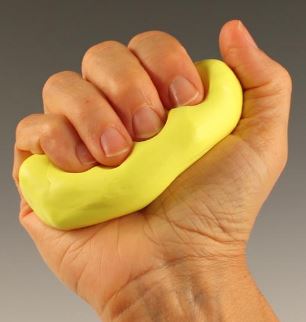
Squeeze putty with all fingers for 3 seconds with 10 repetitions and perform one time per day.
Putty Finger grip Pinch
Pinch the putty between the thumb and first 2 fingers, compressing for 3 seconds with 10 repetitions, and perform one-time per day.
Putty Finger Spread
Flatten putty into a pancake.
Grab the tips of your fingers and thumb together.
Spread the putty over the top of them, and widen them apart.
10 repetitions and do it one time per day.
Putty Key Pinch
Pinch putty between the thumb and the index finger, as if holding a key.
Squeeze for 3 seconds with 10 repetitions and perform one time per day.
Wrist Extension / Flexion
Start with the elbow of your injured wrist resting on the table.
Draw your wrist forward so your wrist flexes downward and fingers naturally open/straighten, and hold.
Then, draw your wrist backward so your fingers fall into a loose fist.
Do 10 repetitions and perform three times per day.
Wrist Side to Side Motion
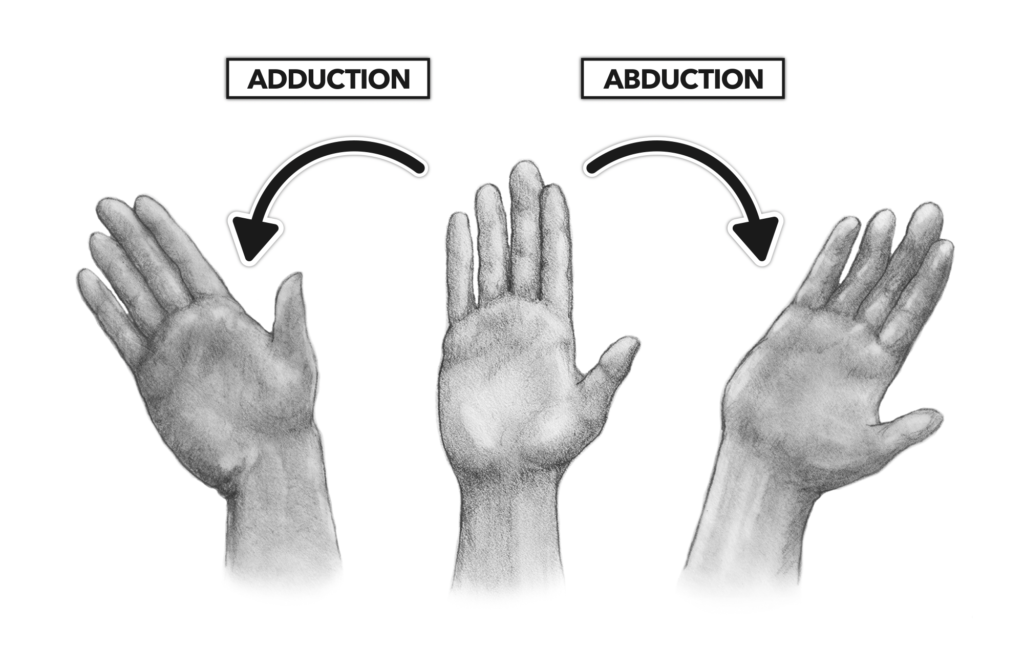
Place your palm flat on the table.
Use the other hand to stabilize your forearm just above your wrist.
Move your wrist as much as you can from side to side, keeping your palm flat on the table at all times.
Do 10 repetitions and perform three times per day.
Forearm Rotation
Sit up straight in a chair with your elbow flexed 90 degrees, in a handshake position.
Roll your forearm palm up, hold 10 seconds, and then palm down, hold 10 seconds.
Do 10 repetitions and perform three times per day.
Tendon Gliding Combo

Begin with your fingers and wrist straight. Without moving your wrist, do the following motions:
Bend the tips of your fingers into a claw position.
Curl the fingers into a fist (without the thumb).
Bend your fingers as if waving, keeping the fingers straight.
Bend the fingers down, reaching to the base of the palm.
Straighten fingers to the beginning position.
Do 10 repetitions and perform six times per day.
Single Finger Bends
With your arm up in the air, flex each finger, one at a time, to the base of the palm and then straighten.
Do 10 repetitions and perform six times per day.
Thumb Circles
Rotate your thumb in circles, in both directions, and keep your wrist stagnant.
Make as wide a circle as possible, gently.
Do 10 repetitions and perform three times per day.
Thumb to Fingertips
Touch the thumb to the tip of each finger. When you come to the little finger, move the thumb down the little finger, towards the palm.
Do 10 repetitions and perform three times per day.
Wrist Exercises for Strength
These are some wrist exercises for gaining strength:
- Palms to the sky/Palms to the floor
- Fist to jazz hand
- Rotation
- Wrist curl
- Loosen-up stretch
- Prayer stretch
- Prayer stretch with a steeple
- Ball squeeze strengthener
- Rubber band strengthener
- Resistance band exercise 1
- Resistance band exercise 2
- Wrist walking
- Grip strengthening
- Wrist Extension With Dumbbell
- Dumbbell Wrist Flexion
- Wrist Supination With Dumbbell
- Wrist Pronation With Dumbbell
- Band Press
- Fingertip High Plank
- Pole Twist
- Palm Pulses
- Back of the Hand Wrist Extension
- Seal Walk
- Rear Facing Wrist Holds
Palms to the sky/Palms to the floor
This gentle exercise gives a tiny stretch to your wrists while improving strength.
While sitting or standing, move your arms out in a T position.
Rotate hands so palms are facing upward towards the sky.
Rotate hands so palms are facing down towards the floor.
Repeat 10 times.
Try to keep your shoulders and neck relaxed. The motion should be just in your wrists, not your elbows, arms, or shoulders.
Fist to jazz hand
This is another gentle exercise that concentrates on hand flexibility and strength.
Place one arm on a table, like you’re about to arm-wrestle someone.
Make a fist.
Slowly open the fist and stretch your fingers out as wide as you can comfortably go (do a jazz hand).
Do it 10 times, then switch arms. Singing “All That Jazz” is optional.
Rotation

You can perform this with no weights, light resistance bands, or 1–5 pound dumbbells. Start with no weights and add weight only if you feel no pain.
Sit with your arms flexed to 90 degrees and forearms out in front of you with palms facing down.
Grab a light resistance band or dumbbells, or go weight-free and pretend you’re holding something.
Slowly rotate your hands so your palms are facing upward.
Slowly rotate your palms back to the initial position.
Repeat 10 times.
Wrist curl
You can perform this exercise with a resistance band, a dumbbell, or just bodily resistance. If you’re using a light resistance band, grasp one end of the band down with the bottom of your foot and grab the other end with your working hand. For dumbbells, stay with 1–5 pounds, depending on your level.
Sit and hold your arm at 90 degrees, with your palm facing upward. Put your arm on your leg, a bench, or a table.
Curl your wrist up, like it’s performing a baby biceps curl.
Return wrist to the initial position.
Repeat 10 times, then switch sides.
Ensure to move only your wrist. This isn’t a biceps curl, it’s a wrist curl, so keep your arm and shoulder stable while your wrist does all the work.
Pronated wrist curl
These are pretty much upside-down wrist curls. You can utilize a dumbbell, a band, or nothing at all!
Sit and hold your arm at 90 degrees, with your palm facing down.
Curl your wrist up.
Return wrist to the beginning position.
Repeat 10 times, then switch sides.
As with the previous move, make sure the motion is only in your wrist. You may need to position your arm so your wrist can hang off your leg or a bench. If your wrist begins by hanging down about 90 degrees, you’ll get a better range of motion for the exercise.
Loosen-up stretch
This is a simple stretch to loosen up your fingers and hands before you start exercising. It’s also a best break to relax your wrists and hands if you’re performing repetitive hand motions.
Sit comfortably and flex your arm at the elbow at a right angle.
Make a fist, and then gently open it spreading and stretching your fingers apart.
Repeat a few times.
Repeat with your opposite hand.
Prayer stretch

Stand with your elbows flexed and palms together, fingertips pointing up at a level that’s just below your chin.
Lower your hands toward your waist, maintaining your hands pressed together and close to your stomach.
When you feel a moderate stretch in the underside of your forearms, hold the position for 30 seconds.
Repeat 2 to 4 times.
You’ll experience this stretch more if you can keep your fingers together. Your fingers will likely start to bend as you move your hands lower.
Prayer stretch with a steeple
Stand with your elbows flexed and palms together in the same hands-together position.
Spread your thumbs and fingers as wide apart as you can. Then draw your palms apart and together again, keeping your fingers and thumbs touching. Do it few times during the day.
Ball squeeze strengthener
You can perform this exercise with any kind of ball, about the size of a tennis ball. Or you can utilize exercise putty, which comes in soft, medium, and hard strengths.
You can also utilize a rolled-up towel or pool noodle for squeezing.
Sit comfortably and take the ball or putty in your hand, wrapping your fingers and thumb around it.
Squeeze as hard as you can.
Pause the squeeze for 3 to 5 seconds.
Relax your grip slowly.
Repeat 8 to 10 times.
Rubber band strengthener
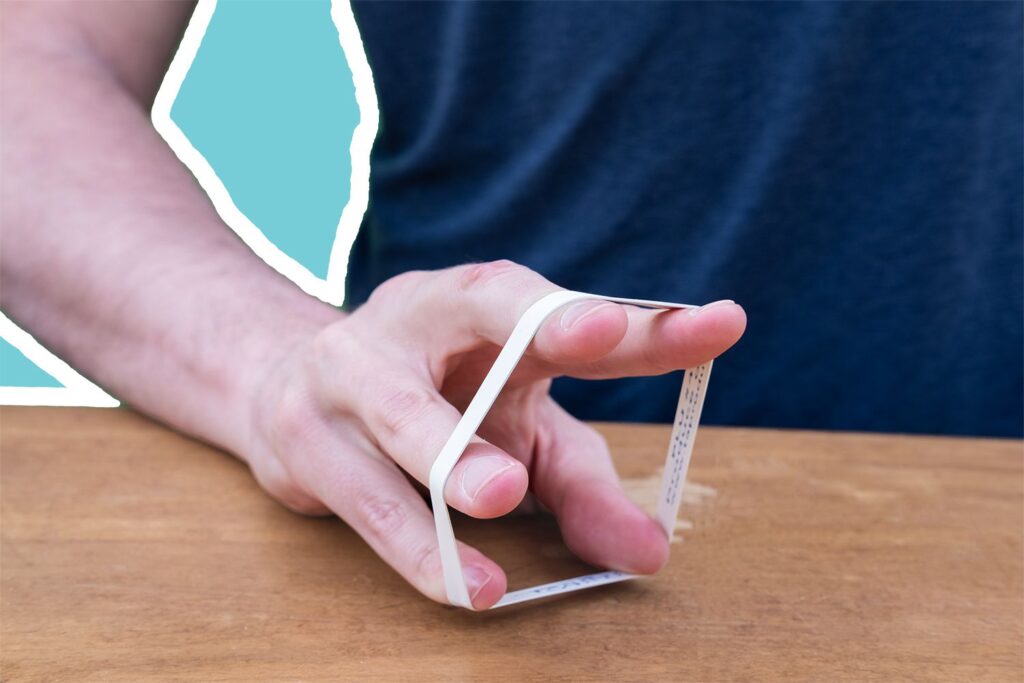
This exercise is simple, but it functions the smaller hand muscles. It’s also one you can perform sitting at a desk or anywhere else.
Take an ordinary rubber band, and stretch it around the tips of your fingers and thumb.
Gently open your hand to stretch against the rubber band, and then slowly close your hand. Keep the motion-controlled.
Repeat 5 to 10 times.
Resistance band exercise 1
Resistance bands are versatile and simple exercise aids. They come in different strengths. If you’re recovering from an injury, begin with a light resistance band. But if you’re coaching for a sport, choose a heavier band.
This works your wrist flexors and extensors.
Sit comfortably, placing your arm on a table with your palm facing down and your hand hanging over the table edge.
Place one end of the resistance band under your foot to hold it down, and hold the other end in your hand. You may have to wrap it is around your hand to create some tension.
Pull up against the resistance, straightening your wrist as far as you can. Keep the movement smooth and controlled.
Slowly come back down to the beginning pose.
Repeat 10 times.
Repeat with your opposite hand.
Do the same exercise, but begin with your palms facing up.
Resistance band exercise 2
Sit comfortably with your arms close to your body, and flex at right angles.
Hold a band tight with both hands, palms down.
Slowly roll your wrists so that your palms are facing up, stretching the band.
Keep your arms and elbows in place.
Repeat a few times.
Wrist walking
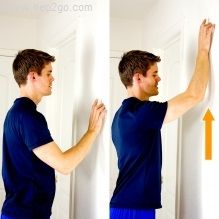
Stand near a wall, with your arms extended, your palms against the wall, and your fingers pointed upward.
Maintaining your palms against the wall, walk your wrists down the wall as far as you can.
Then turn your hands around so that your fingers are pointed downward. With your palms against the wall, walk your wrists back up as far as you can.
Grip strengthening
Grippers come in a variety of tensions. You can begin with one that’s only a little difficult to close. When that becomes easy, improve the gripper tension. Grippers range from light to ones needing 365 pounds of pressure to close.
Sit comfortably with your arms flexed at a right angle, palm facing in, holding the gripper in one hand.
Compress slowly, and release.
Repeat 5 to 10 times.
Only your hand should be moving, not the arm.
Switch hands and do it again.
When you can comfortably perform 2 to 4 sets, try a gripper with more tension.
Wrist Extension With Dumbbell
To begin these wrist strengthening exercises, sit in a chair with your forearm resting on a table. Swing your wrist and hand over the edge of the table.
Hold a 1- or 3-pound dumbbell in your hand. Then, with your palm facing down, slowly raise your hand, so the back of your the hand moves towards the roof. The forearm should remain on the table.
Once your wrist is fully extended, hold the pose for a few seconds, then slowly lower your hand down. Repeat this movement for 10 to 15 repetitions. Do two to three sets.
Dumbbell Wrist Flexion
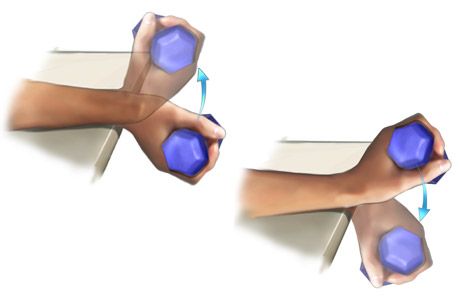
After doing wrist extensions, continue resting your forearm on the table. Then, turn your hand over, so your palm is facing the roof.
Hold the dumbbell and maintain your forearm against the table. Then, bent your wrist up so that your palm moves towards the ceiling.
Once your wrist is fully flexed, hold the pose for two to three seconds. Then, slowly lower your hand back to the beginning position.
Repeat the wrist flexion exercise for three to four sets of 10-15 repetitions. Then move on to the next activity.
Wrist Supination With Dumbbell
Wrist supination refers to the motion of turning your wrist over, so your palm is face-up. The main muscles that aid to turn your wrist over is the biceps muscle in your upper arm and smaller muscles in the forearm.
To do this exercise, sit in a chair with your forearm placed on a table. Ensure your wrist and hand are over the edge of the table.
Grab the end of a small 1- to 3-pound dumbbell in your hand, like you would hold a hammer.
Slowly allow your hand and wrist to roll over so your palm is face up towards the roof.
Hold the last position for a few seconds, then slowly roll your hand back up, so the dumbbell is straight up once again.
You can then allow your hand and wrist to slowly roll over, so your palm is facing downward (a position called pronation). Hold this position for a second or two. Then, slowly rotate your hand back upward, so the weight is pointing to the roof.
Repeat this exercise for 12 to 15 repetitions. Perform two to three sets.
Wrist Pronation With Dumbbell
Wrist pronation refers to the pose of your hand facing down as if you were pouring a pitcher of water.
To strengthen your wrist pronators, sit in a chair with your forearm supported on a table and your hand and wrist over the edge.
Hold one end of a dumbbell with the weight pointing up towards the roof.
Gently rotate your hand, so your wrist and palm are facing down towards the ground. Stay in this pose for a few seconds, then slowly turn your hand back to the beginning position with the weight pointing up towards the ceiling.
Slowly let your wrist rotate, so your palm is facing up.
Once your palm is facing up, hold the last position for a few seconds, then slowly return your wrist to the beginning position.
Perform two to three sets of 10 to 15 repetitions.
Band Press
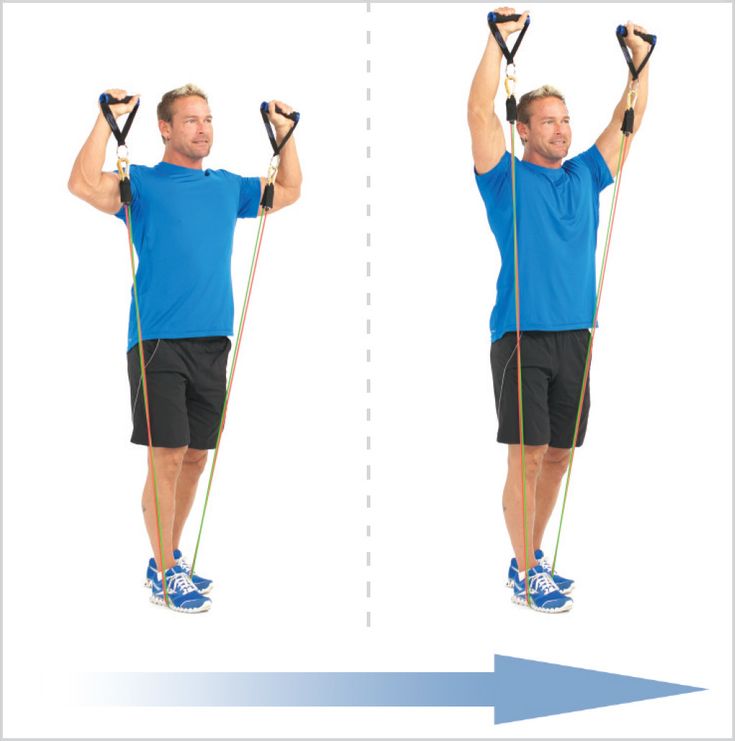
Grasp a bungee cord or exercise band tied in a one-foot loop. Place your hands inside the loop, palms facing each other, hands-on either side of the band, keeping pressure. Flex your elbows so that your upper arms are pressed to your sides and your forearms are extended in front of you, parallel to the floor. Without moving your elbows from the sides or breaking at the wrists, press your hands away from each other as far as they will go. Release. Perform 10 reps, 4 sets.
Fingertip High Plank
You have 10 bones that are joined to the wrist joint (two from your forearm and eight from your hand, a.k.a. carpals). Engaging these bones in exercise aid strengthen the whole hand/wrist unit. To begin, get into a high plank (arms straight) position. As always, maintain your back flat and body in one long line from your head to your toes. From there, shift your weight to your right side and extend your left fingers so that you are balancing on your fingertips. Shift your weight back to the left and extend your right fingers as well. Return to the center and find your balance at your fingertips. Hold for one minute.
Pole Twist
Find a sturdy and stable vertical pole (it could be an iron railing, a table leg, or part of your kid’s jungle gym). Grasp it with both hands (one stacked over the other). Using all your force, twist your hands in other directions as if you are trying to dislodge the pole (except that by twisting one hand against the opposite one, nothing will happen). Hold the twist tension for about 8-10 seconds; release. Repeat, twisting your hands in the other direction of your previous twist. Perform 5 sets of twisting total.
Palm Pulses
Palm pulses strengthen your wrists.
Put your hands flat on the floor, splaying your fingers as wide as you can.
Pull your palms off the floor, keeping the top part of your hand and your fingers pressed into the floor.
Pulse in and out of this pose 10-30 times.
Back of the Hand Wrist Extension
Begin with your knuckles on the ground with your arms straight.
Alter your weight by sitting back or leaning forward.
Open your palms, and rotate the back of your hands to be flat on the floor.
Perform 2 sets of 8-10 reps.
Seal Walk
Begin with your palms on the ground, with fingers facing your knees.
Shoulders over your hands.
Walk forward, crawling on your knees and hands, trying to keep your chest up.
Perform 2 sets of 10-12 reps per hand.
Rear Facing Wrist Holds
Begin with the back of your hands on the floor, fingers pointing toward your knees.
Hold the pose for 3-10 seconds and goal to work toward a full 30-second hold.
Sprained Wrist Exercise
Here are some exercises which you can perform after a wrist sprain:
- Gripping Exercises
- Radial and Ulnar Deviation
- Resistance Extension and Flexion
- Wrist Stretches
- Wrist Strengthening
- Power Squeeze
- Full Finger Spread
Gripping Exercises
Grip strength is an essential part of wrist function. For this exercise, use a small ball. Cover your fingers around the ball and compress as hard as you can for five seconds. Release and repeat the exercise at least 10 times.
Radial and Ulnar Deviation
For radial and ulnar deviation exercises, draw your affected hand in front of you. Slowly flex the wrist as far as you can from the side to side. With each flex, hold the position for at least six seconds and then switch to the other direction. Repeat at least 10 times.
Resistance Extension and Flexion
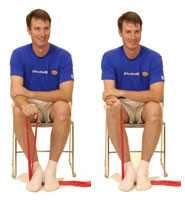
For resistance wrist extension and flexion exercises, you will need to utilize an exercise band. Take a sit on a chair, keep your legs apart, and lean forward with the forearm placed on your thigh and the hand in front of your knee. Grasp one end of the exercise band, wrap it around the affected hand (with your palm facing downward), and step on the other with your foot. For a wrist extension exercise, slowly flex your wrist upward and hold the position for a couple of seconds. Then, flex it downward and hold it for a few seconds. Do this exercise at least 8 times.
For the wrist flexion exercise, wrap the end of the exercise band with your palm facing upward. Flex the wrist upward and hold for a couple of seconds, then flex it downward for another few seconds. Repeat at least 8 times.
These exercises can also be performed without resistance with the affected arm resting on a table and the hand and wrist placed over the edge of the table. Move the hand up and slowly close it into a fist. Pause for a few seconds, then lower the hand and permit fingers to relax. Repeat at least 8 times.
It is usually suggested that patients begin to exercise and physical therapy only once they’ve gotten past the initial recovery stage and wrist pain has begun to fade. Understanding how to begin with exercise is very important.
Wrist Stretches
Wrist range of motion will be the first step in beginning a home program when you are ready. This will aid restore normal wrist function, relieve stiffness and is a great warm-up for higher-level wrist exercises when possible.
Wrist Flexion and Extension
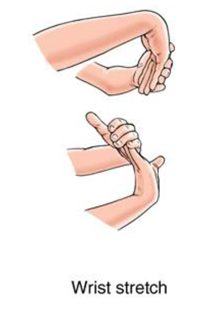
Sit with the arm supported and the wrist free to move. With the palm facing down toward the ground and fingers in a gentle fist, you will simply be flexing and extending the wrist as far as you can comfortably go. Keep the movement slow and controlled. At the top of each direction, you can stop and pause it for 1-3 seconds for a further stretch as well. Alternate 10-15 times in each direction for up to 2 sets per day.
Wrist Radial and Ulnar Deviation
Your beginning position will be the same as it was for wrist flexion and extension with the palm facing down. This time you will be moving the wrist from side to side toward the pinky side and then the thumb side. This is a very small wrist motion so don’t force it. Make sure to keep the wrist neutral (not flexed or extended) throughout the exercise. Alternate 10-15 times in each direction for up to 2 sets per day.
Wrist Pronation and Supination
Keep the wrist supported again. This time you will be rolling the wrist and forearm rhythmically. Keep the elbow and shoulder still, as you rotate the hand to face the palm up toward the roof. Then, reverse the movement and let it rotate down toward the ground. Keep the wrist neutral throughout. Alternate 10-15 times in each direction for up to 2 sets per day.
Wrist Strengthening
If wrist range of motion is well tolerated, the next step will be to begin rebuilding muscle strength in the wrist. You will be adding weights or resistance to the range of motion exercises. Always begin with small weights and progress from there. Grasp a 1-pound dumbbell, water bottle, or soup can to get started.
Wrist Flexion
Sit or stand with the forearm supported and wrist free to move. This can be performed with a table, your knee, or the opposite hand. Hold the weight in your hand with the palm facing up toward the roof. Then, raise the palm up toward the ceiling as you flex the wrist. Make sure the movement is controlled as you return to the starting position and repeat. Repeat up to 10-15 times for 2 sets each day.
Wrist Extension
Follow the same setup for supporting the arm as you did with wrist flexion. Now, grab your weight in your hand with your palm facing down toward the ground. Raise the back of the hand toward the roof as you extend the wrist. Keep the range of motion comfortable. Move for a count of 2 in each direction. Repeat 10-15 times for up to 2 sets each day.
Wrist Radial Deviation
Again, keep your wrist supported as you proceed with your strength program like the two exercises above. This time you will turn your wrist so that your thumb is facing up toward the roof. The wrist motion is a small sideways bend as you raise your the thumb side of the wrist up toward the roof. Keep the wrist neutral (not bent or extended) as you complete this small move.
Repeat 10-15 times for up to 2 sets each day.
Wrist Pronation and Supination
You will begin in the same position as the wrist radial deviation above. This time you will be rolling the wrist from side to side while keeping the elbow and upper arm fully still. Simply turn the hand until the palm is facing the roof before switching directions so that the palm is now facing the ground. To add further resistance, try using a hammer or grasping your weight at the base so that most of it is above your fist. Repeat 10-15 times slowly for up to 2 sets a day.
Power Squeeze
Grasp some therapy putty, a small ball, or rolled towel to address all the muscles in your hand and wrist at once with a powerful squeeze. Put your strengthening tool in your palm and wrap your fingers around it. Then, squeeze as hard as you can comfortably and hold for up to 3-5 seconds at a time. Do it 10-15 times for up to 2 sets.
Full Finger Spread

For this one, grasp a rubber band, therapy putty, or hand extension exerciser to work the back of the hand and fingers. Put the band around the fingers, keeping them as close together as possible to begin. Then, splay the fingers apart as far as possible while pushing against the resistance. Hold for 2-3 seconds before slowly returning to the beginning position. Repeat 10-15 times for up to 2 sets each day.
Wrist Exercise for Arthritis
Here is the list of some wrist exercises for arthritis:
- Make a fist
- Finger bends
- Thumb bend
- Make an ‘O’
- Table bend
- Finger lift
- Wrist stretch
- Roll back and forth
- Full grip
- Thumb extension
- Finger stretch
- Hand clench
- Side-to-side wrist bend
- Finger curl
- Soft hand massage
- Wrist and Hand Stretch
Make a fist
You can do this exercise anytime and anywhere your hand feels stiff.
Start by holding your right hand out, with all of your fingers straight.
Then gently bend your hand into a fist, positioning your thumb on the outside of your hand. Be gentle and don’t compress your hand.
Open your hand reverse until your fingers are straight once again.
Perform the exercise 10 times with your right hand.
Repeat the whole sequence with your left hand.
Finger bends
Start in the same position as in the last exercise, with your right hand held up straight.
Flex your thumb down toward your palm. Pause it for a couple of seconds, then straighten it.
Flex your index finger down toward your palm. Hold it for a couple of seconds, then extend it.
Do it with the remaining fingers on your right hand, one at a time.
Repeat the entire steps on your left hand.
Thumb bend
First, hold your right hand out, with all of your fingers extended.
Flex your thumb inward toward your palm.
Stretch toward the end of your pinky finger with your thumb. If you can’t touch your pinky, don’t worry. Just stretch your thumb as far as you can.
Hold the pose for 1 or 2 seconds, then return your thumb to the beginning position.
Repeat 10 times.
Do the exercise with your left hand.
Make an ‘O’
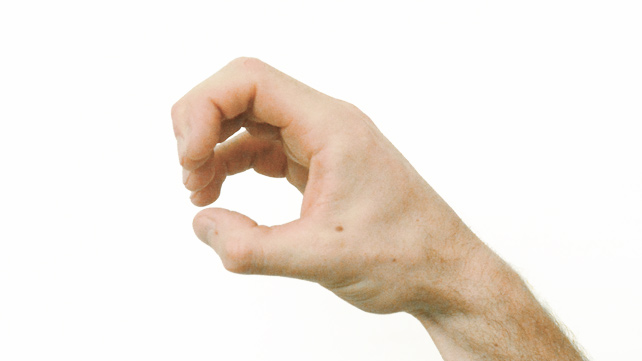
Perform this exercise a few times a day on each hand. You can perform this stretch whenever your hands feel achy or stiff.
Start with your right hand out and fingers straight.
Curve all of your fingers inward until they touch. Your fingers should create the shape of an “O.”
Hold this pose for a few seconds. Then, straighten your fingers again.
Repeat on the opposite hand.
Table bend
Place the pinky-side edge of your right hand on a table, with your hand straight out and your thumb pointed up.
Holding your thumb in the same position, flex the other four fingers inward until your hand makes an “L” shape.
Pause it for a couple of seconds, then straighten your fingers to move them back into the beginning position.
Repeat 10 times.
Do the same process on your right hand.
Finger lift
Put your right-hand flat on a table, palm down.
Beginning with your thumb, lift each finger slowly off the table one at a time.
Hold every finger for 1 or 2 seconds, then lower it.
Repeat the entire sequence with the left hand.
Wrist stretch
Don’t ignore your wrists, which can also get sore and stiff from arthritis.
To exercise your wrist, hold your left arm out with the palm facing down.
With your right hand, gently press down on the left hand until you feel a stretch in your wrist and arm.
Hold the pose for a few seconds.
Repeat 10 times.
Then, do the entire sequence with the right hand.
Roll back and forth
Practice this exercise with a small ball, such as a tennis ball or stress ball.
Put the ball on a flat surface such as a table.
Utilizing your left hand, roll the ball from your palm to the tips of your fingers to stretch out each digit.
Roll the ball back to its starting position.
Repeat this exercise with your right hand.
Full grip
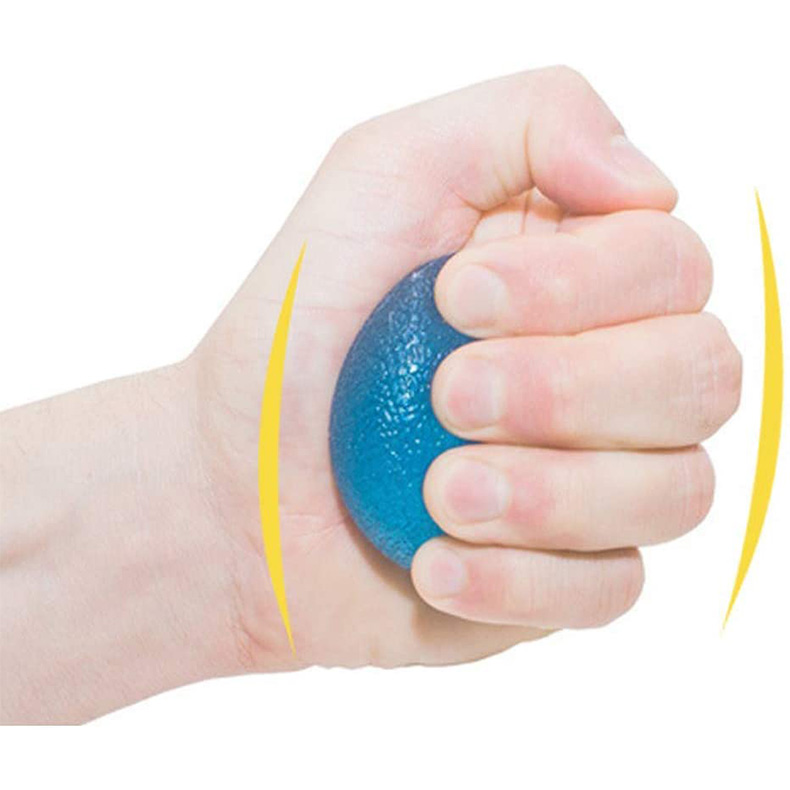
Try the following exercises with a stress ball, tennis ball, or another soft ball of a similar size. However, if you have damage to your thumb joint or have an active flare in your hands, you may need to prevent this exercise and talk with a doctor about other options.
Only perform this exercise a few times per week, with at least 48 hours of rest in between.
Using your left hand, squeeze the ball as hard as you can for a few seconds.
Release the ball.
Do this exercise 15 times.
Then, do the exercise with your right hand.
Thumb extension
Perform this exercise 3 times per week.
Place one or more elastic bands around all of your fingers and make a loose fist with your left hand.
Rest your hand on a flat surface.
Flex and move your thumb away from the hand.
Hold for 5 seconds.
Repeat this exercise 12 to 15 times.
Do the exercise with your right hand.
Finger stretch
Perform this exercise 3 times per week.
Lay your left hand on a flat surface.
Use the right hand to apply gentle pressure to your finger joints. But if the finger joints hurt, you can stretch one finger at a time.
Press for 30 seconds.
Then perform the exercise with your left hand.
Hand clench

Start by straightening the fingers out.
Slowly flex the hand into a fist.
Maintain the thumb on the outside of the hand.
Hold this pose for a couple of seconds, then repeat.
Perform around 10 reps once per day. People can perform so more regularly if the exercise is comfortable and pain-free.
Side-to-side wrist bend
Put the forearm flat on a table, with the palms of the hands facing down.
Bend the wrist as far as possible to the right, hold for 2 seconds, then bend the wrist back to the center.
Repeat this movement to the left, hold for 2 seconds, then move back to the center. This is one set.
Do 10 sets twice per day on each hand.
Finger curl
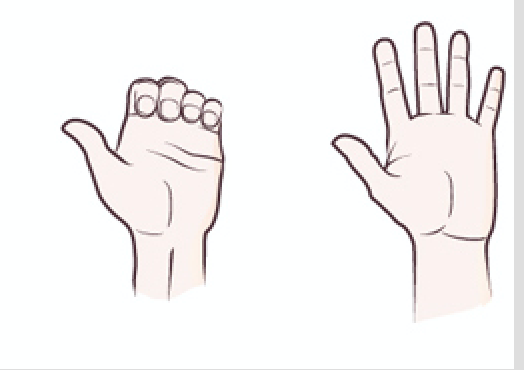
Hold the hand up with the fingers extended and close together.
Flex the end and middle joints of fingers tightly until the fingertips touch the skin on the hand.
Slowly return the fingers to a vertical pose.
Do the finger curl 10 times twice per day.
Soft hand massage
To do a soft hand massage, massage the palm with the opposite thumb using short strokes. Also, massage the fingers beginning at the tops, then pushing down toward the palms.
Wrist Rotations
Lay your wrists on a flat surface, such as a table, with your palms facing down. Rotate your wrists so that your palms are facing up towards the roof, and then roll them back down to lie flat on the table. This is one full repetition. Do ten repetitions.
Wrist Circles
Lay your wrists on a flat surface, such as a table, with the hands hanging off the edge. Draw your wrist in full, clockwise circles, then switch, and move them in full, counterclockwise circles. Do five of each.
Wrist Resister
Put your palms flat against one another and hold them in front of you. Use your left palm to press against your right palm and bend the right wrist backward while trying to resist with your right wrist. Do five repetitions on one hand, then repeat with the another hand.
Wrist and Hand Stretch
Hold your arms out in front of you with the palms pointing away from you. Flex your wrist downward so that your fingertips are pointing at the ground, then lift your hands back up to the beginning position. This is one repetition. Do this action ten times.
These exercises will aid loosen the stiffness in your wrist joints to decrease pain and improve your range of motion. They will also help reduce any pain that you’re feeling in your hands and finger joints from rheumatoid arthritis. They can be performed every day, or every other day, but if you’re feeling fatigued from the exercises, you may want to cut back.
How to take Safety and avoid Injury while Wrist Exercise?
If you have a previous or pre-existing health condition, consult your physician before starting an exercise program. Proper exercise technique is important to ensure the safety and effectiveness of an exercise program. Always select a weight that allows you to have full control of your body throughout the motion. When doing any exercise, pay close attention to the body, and stop immediately if you feel pain or discomfort.
To see continual progress and boost body strength, incorporate proper warm-ups, rest, and nutrition into your exercise program. Your results will ultimately be based on your ability to adequately recover from your workouts. Rest for 24 to 48 hours before training the same muscle groups to permit sufficient recovery.

